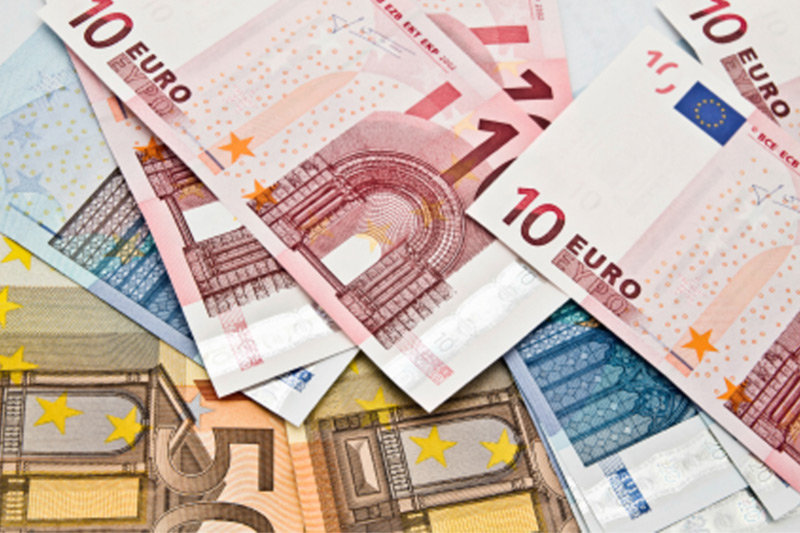Investing.com - The euro turned lower against the other major currencies on Thursday, as hopes for policy measures from the European Central Bank to stem the euro zone debt crisis waned, while concerns over the outlook for growth also weighed.
During European late morning trade, the euro was down against the U.S. dollar, with EUR/USD falling 0.43% to 1.2311.
Optimism that the ECB will soon move to lower high Spanish and Italian borrowing costs faded as investors waited for more details of the bank’s proposed bond buying program to emerge.
Sentiment was also hit after the ECB said in its monthly bulletin that the economic outlook for the euro zone faced a number of downside risks, with financial market tensions and their potential impact on growth posing the key threats.
The ECB revised down its forecast for economic growth to 0.6% in 2013, down from 1% previously and forecast a 0.3% contraction in growth this year, slightly worse than its previous forecast of for a 0.2% contraction.
The euro had been slightly higher against the greenback earlier, as risk assets were buoyed up by prospects for further monetary stimulus by China.
Official data showed that consumer inflation slowed in July from the previous month, indicating that China’s central bank has more scope for monetary easing, following interest rates cuts in June and July.
The single currency was also weaker against the pound, with EUR/GBP losing 0.34% to trade at 0.7870.
In the U.K., official data showed that the goods deficit jumped to GBP10.1 billion in June, up from GBP8.36 billion in May, on the back of a 7% drop in exports. Analysts had expected that trade deficit to tick up to GBP8.6 billion.
The data came one day after the Bank of England said that the U.K. economy would barely grow this year and cut its forecasts for the coming years in its quarterly inflation report.
However, BoE Governor Mervyn King did indicate that a rate cut was unlikely in the coming months, saying it would damage some financial institutions.
The euro was lower against the yen, with EUR/JPY down 0.36% to 96.62.
The Bank of Japan left monetary policy unchanged earlier, in a widely anticipated decision. The central bank also indicated that it would not implement further stimulus measures unless the yen continued to appreciate.
The euro was little changed against the Swiss franc, with EUR/CHF dipping 0.01% to 1.2010.
The shared currency was trading close to record lows against the Australian, Canadian and New Zealand dollars, with EUR/AUD down 0.53% to 1.1636, EUR/CAD losing 0.44% to trade at 1.2238 and EUR/NZD dipping 0.09% to hit 1.5150.
The Aussie strengthened broadly after official data showed that Australia’s economy added more jobs than forecast in July, while the unemployment rate unexpectedly ticked lower.
Elsewhere, government data showed that New Zealand’s economy added fewer than forecast jobs in the second quarter and the country’s unemployment rate climbed unexpectedly.
Later Thursday, the U.S. was to release official data on the trade balance and a weekly report on initial jobless claims.
During European late morning trade, the euro was down against the U.S. dollar, with EUR/USD falling 0.43% to 1.2311.
Optimism that the ECB will soon move to lower high Spanish and Italian borrowing costs faded as investors waited for more details of the bank’s proposed bond buying program to emerge.
Sentiment was also hit after the ECB said in its monthly bulletin that the economic outlook for the euro zone faced a number of downside risks, with financial market tensions and their potential impact on growth posing the key threats.
The ECB revised down its forecast for economic growth to 0.6% in 2013, down from 1% previously and forecast a 0.3% contraction in growth this year, slightly worse than its previous forecast of for a 0.2% contraction.
The euro had been slightly higher against the greenback earlier, as risk assets were buoyed up by prospects for further monetary stimulus by China.
Official data showed that consumer inflation slowed in July from the previous month, indicating that China’s central bank has more scope for monetary easing, following interest rates cuts in June and July.
The single currency was also weaker against the pound, with EUR/GBP losing 0.34% to trade at 0.7870.
In the U.K., official data showed that the goods deficit jumped to GBP10.1 billion in June, up from GBP8.36 billion in May, on the back of a 7% drop in exports. Analysts had expected that trade deficit to tick up to GBP8.6 billion.
The data came one day after the Bank of England said that the U.K. economy would barely grow this year and cut its forecasts for the coming years in its quarterly inflation report.
However, BoE Governor Mervyn King did indicate that a rate cut was unlikely in the coming months, saying it would damage some financial institutions.
The euro was lower against the yen, with EUR/JPY down 0.36% to 96.62.
The Bank of Japan left monetary policy unchanged earlier, in a widely anticipated decision. The central bank also indicated that it would not implement further stimulus measures unless the yen continued to appreciate.
The euro was little changed against the Swiss franc, with EUR/CHF dipping 0.01% to 1.2010.
The shared currency was trading close to record lows against the Australian, Canadian and New Zealand dollars, with EUR/AUD down 0.53% to 1.1636, EUR/CAD losing 0.44% to trade at 1.2238 and EUR/NZD dipping 0.09% to hit 1.5150.
The Aussie strengthened broadly after official data showed that Australia’s economy added more jobs than forecast in July, while the unemployment rate unexpectedly ticked lower.
Elsewhere, government data showed that New Zealand’s economy added fewer than forecast jobs in the second quarter and the country’s unemployment rate climbed unexpectedly.
Later Thursday, the U.S. was to release official data on the trade balance and a weekly report on initial jobless claims.
